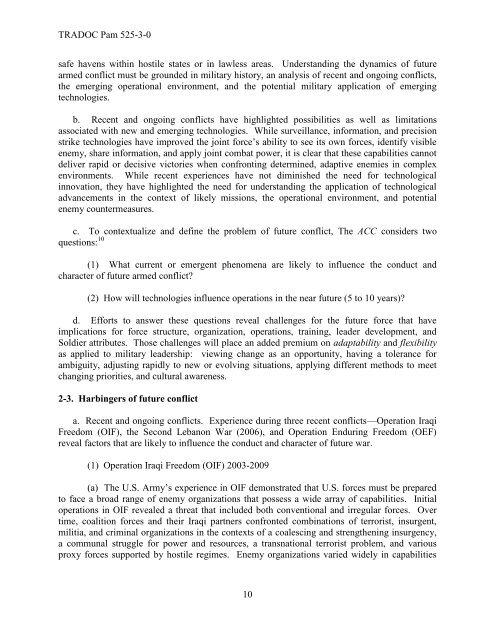(Pam) 525-3-0, The Army Capstone Concept - Federation of ...
(Pam) 525-3-0, The Army Capstone Concept - Federation of ...
(Pam) 525-3-0, The Army Capstone Concept - Federation of ...
Create successful ePaper yourself
Turn your PDF publications into a flip-book with our unique Google optimized e-Paper software.
TRADOC <strong>Pam</strong> <strong>525</strong>-3-0<br />
safe havens within hostile states or in lawless areas. Understanding the dynamics <strong>of</strong> future<br />
armed conflict must be grounded in military history, an analysis <strong>of</strong> recent and ongoing conflicts,<br />
the emerging operational environment, and the potential military application <strong>of</strong> emerging<br />
technologies.<br />
b. Recent and ongoing conflicts have highlighted possibilities as well as limitations<br />
associated with new and emerging technologies. While surveillance, information, and precision<br />
strike technologies have improved the joint force’s ability to see its own forces, identify visible<br />
enemy, share information, and apply joint combat power, it is clear that these capabilities cannot<br />
deliver rapid or decisive victories when confronting determined, adaptive enemies in complex<br />
environments. While recent experiences have not diminished the need for technological<br />
innovation, they have highlighted the need for understanding the application <strong>of</strong> technological<br />
advancements in the context <strong>of</strong> likely missions, the operational environment, and potential<br />
enemy countermeasures.<br />
c. To contextualize and define the problem <strong>of</strong> future conflict, <strong>The</strong> ACC considers two<br />
questions: 10<br />
(1) What current or emergent phenomena are likely to influence the conduct and<br />
character <strong>of</strong> future armed conflict?<br />
(2) How will technologies influence operations in the near future (5 to 10 years)?<br />
d. Efforts to answer these questions reveal challenges for the future force that have<br />
implications for force structure, organization, operations, training, leader development, and<br />
Soldier attributes. Those challenges will place an added premium on adaptability and flexibility<br />
as applied to military leadership: viewing change as an opportunity, having a tolerance for<br />
ambiguity, adjusting rapidly to new or evolving situations, applying different methods to meet<br />
changing priorities, and cultural awareness.<br />
2-3. Harbingers <strong>of</strong> future conflict<br />
a. Recent and ongoing conflicts. Experience during three recent conflicts—Operation Iraqi<br />
Freedom (OIF), the Second Lebanon War (2006), and Operation Enduring Freedom (OEF)<br />
reveal factors that are likely to influence the conduct and character <strong>of</strong> future war.<br />
(1) Operation Iraqi Freedom (OIF) 2003-2009<br />
(a) <strong>The</strong> U.S. <strong>Army</strong>’s experience in OIF demonstrated that U.S. forces must be prepared<br />
to face a broad range <strong>of</strong> enemy organizations that possess a wide array <strong>of</strong> capabilities. Initial<br />
operations in OIF revealed a threat that included both conventional and irregular forces. Over<br />
time, coalition forces and their Iraqi partners confronted combinations <strong>of</strong> terrorist, insurgent,<br />
militia, and criminal organizations in the contexts <strong>of</strong> a coalescing and strengthening insurgency,<br />
a communal struggle for power and resources, a transnational terrorist problem, and various<br />
proxy forces supported by hostile regimes. Enemy organizations varied widely in capabilities<br />
10
















